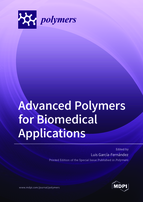Advanced Polymers for Biomedical Applications
A special issue of Polymers (ISSN 2073-4360). This special issue belongs to the section "Biomacromolecules, Biobased and Biodegradable Polymers".
Deadline for manuscript submissions: closed (28 February 2022) | Viewed by 76881
Special Issue Editor
2. Networking Biomedical Research Centre in Bioengineering, Biomaterials and Nanomedicine (CIBER-BBN), Monforte de Lemos 3-5, Pabellón 11, 28029 Madrid, Spain
Interests: antimicrobials; biomaterials; natural polymers; polymers; polymer composites; nanomaterial; scaffold; surface modification; drug delivery; tissue engineering
Special Issue Information
Dear Colleagues,
Polymers are the largest and most versatile class of biomaterials being extensively applied for therapeutic applications. From natural to synthetic polymers, the possibilities to design and modify their physical–chemical properties make these systems of great interest in a wide range of biomedical applications as diverse as drug delivery systems, organ-on-a-chip, diagnostics, tissue engineering, and so on.
In recent years, advances in the synthesis and modification of polymers and characterization techniques have allowed the design of novel biomaterials as well as the study of their biological behavior in vitro and in vivo.
The purpose of this Special Issue is to highlight recent achievements from the synthesis and modifications of polymers for biomedical applications to final applications in the field of biomedicine.
Dr. Luis García-Fernández
Guest Editor
Manuscript Submission Information
Manuscripts should be submitted online at www.mdpi.com by registering and logging in to this website. Once you are registered, click here to go to the submission form. Manuscripts can be submitted until the deadline. All submissions that pass pre-check are peer-reviewed. Accepted papers will be published continuously in the journal (as soon as accepted) and will be listed together on the special issue website. Research articles, review articles as well as short communications are invited. For planned papers, a title and short abstract (about 100 words) can be sent to the Editorial Office for announcement on this website.
Submitted manuscripts should not have been published previously, nor be under consideration for publication elsewhere (except conference proceedings papers). All manuscripts are thoroughly refereed through a single-blind peer-review process. A guide for authors and other relevant information for submission of manuscripts is available on the Instructions for Authors page. Polymers is an international peer-reviewed open access semimonthly journal published by MDPI.
Please visit the Instructions for Authors page before submitting a manuscript. The Article Processing Charge (APC) for publication in this open access journal is 2700 CHF (Swiss Francs). Submitted papers should be well formatted and use good English. Authors may use MDPI's English editing service prior to publication or during author revisions.
Keywords
- hydrogels
- scaffold
- drug delivery system
- tissue engineering
- polymers
- natural polymer
- biomaterial
- synthesis
- modification







